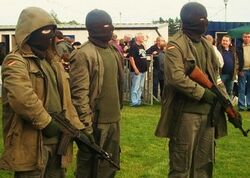Social:Active service unit

An active service unit (ASU; Irish: aonad seirbhíse cogúla)[1][2] was a Provisional Irish Republican Army (IRA) cell of four to ten members, tasked with carrying out armed attacks.[3] In 2002, the IRA had about 1,000 active members of which about 300 were in active service units.[4]
In 1977, the IRA moved away from the larger conventional military organisational principle owing to its perceived security vulnerability. In place of the battalion structures, a system of two parallel types of unit within an IRA Brigade was introduced. Firstly, the old "company" structures were used to supply auxiliary members for support activities such as intelligence-gathering, acting as lookouts or moving weapons.[5]
The bulk of attacks from 1977 onwards were the responsibility of a second type of unit, the ASU. To improve security and operational capacity these ASUs were smaller, tight-knit cells, usually consisting of five to eight members, for carrying out armed attacks. The ASU's weapons were controlled by a quartermaster under the direct control of the IRA leadership.[6] By the late 1980s and early 1990s, it was estimated that the IRA had roughly 300 members in ASUs and approximately 450 serving in supporting roles.[7]
The exception to this reorganisation was the South Armagh Brigade which retained its traditional hierarchy and battalion structure and used relatively large numbers of volunteers in its actions.[8] Some operations, like the attack on Cloghogue checkpoint or the South Armagh sniper squads, involved as many as 20 volunteers, most of them in supporting roles.[9]
The smaller Republican paramilitary organisation the INLA also used the term "active service unit,[10] as did the Loyalist paramilitary groups the Ulster Volunteer Force[11] and Ulster Defence Association.[citation needed]
See also
- Flying Columns, terminology for some types of Irish Volunteers units of circa the 1920s
- Fireteam and Squad, terminology for functional types of modern military units of similar size
References
- ↑ "Achtanna Den Oireachtas a Ritheadh Sa Bhlia[in ...: 1937"]. Stationery Office. March 8, 1937. https://books.google.com/books?id=PvxQAQAAMAAJ&q=%22Aonad+Seirbh%C3%ADse+Cog%C3%BAla%22.
- ↑ "Ní Neart go cur le Chéile | An Phoblacht". https://www.anphoblacht.com/contents/17229.
- ↑ Leahy, Thomas (2020). The Intelligence War against the IRA. Cambridge University Press. p. 89. ISBN 978-1108487504.
- ↑ Moloney, Ed (2002). A Secret History of the IRA. Penguin Books. pp. xiv. ISBN 0-14-101041-X.
- ↑ O'Hearn, page 19
- ↑ Bowyer Bell Page 437
- ↑ O'Brien, p.161
- ↑ Moloney, p.377
- ↑ Harnden, Toby (2000). Bandit Country:The IRA and South Armagh. Coronet books. pp. 404. ISBN 0-340-71737-8. https://archive.org/details/banditcountry00toby/page/404.
- ↑ "Archived copy". https://cain.ulster.ac.uk/nai/1984/nai_DFA-2014-32-13_1983-05-13.pdf.
- ↑ "Statement by the Ulster Volunteer Force (UVF), (3 May 2007)". CAIN. https://cain.ulster.ac.uk/othelem/organ/uvf/uvf030507.htm.
Bibliography
- O'Hearn, Denis. Bobby Sands: Nothing but an Unfinished Song, Pluto, ISBN:0-7453-2572-6
- Bell, J. Bowyer. The Secret Army - The IRA, 1997 3rd Edition, ISBN:1-85371-813-0
- Moloney Ed, The Secret History of the IRA, Penguin, London 2002, ISBN:0-14-101041-X
- O'Brien. Brendan, The Long War - The IRA and Sinn Féin. O'Brien Press, Dublin 1995, ISBN:0-86278-359-3
- ASUs in the Irish War of Independence
 |


